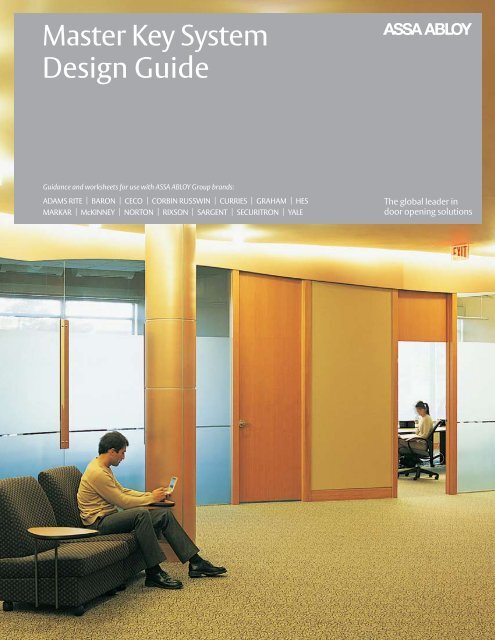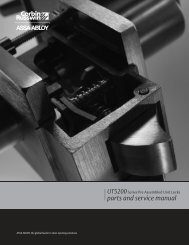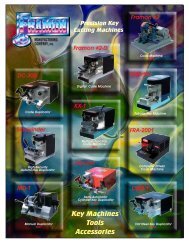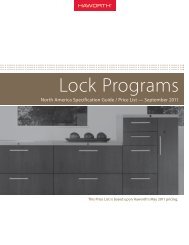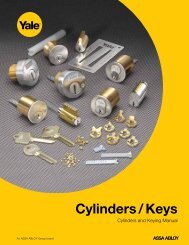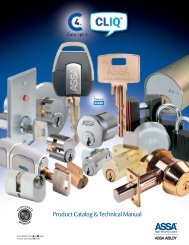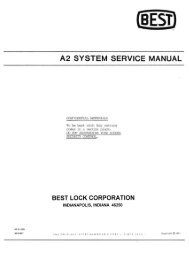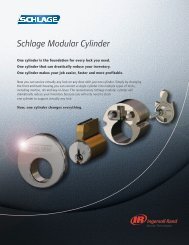Master Key System Design Guide - Sargent Locks
Master Key System Design Guide - Sargent Locks
Master Key System Design Guide - Sargent Locks
- No tags were found...
Create successful ePaper yourself
Turn your PDF publications into a flip-book with our unique Google optimized e-Paper software.
<strong>Master</strong> <strong>Key</strong> <strong>System</strong><strong>Design</strong> <strong>Guide</strong>Guidance and worksheets for use with ASSA ABLOY Group brands:ADAMS RITE | BARON | CECO | CORBIN RUSSWIN | CURRIES | GRAHAM | HESMARKAR | McKINNEY | NORTON | RIXSON | SARGENT | SECURITRON | YALE
IntroductionTable of ContentsTo ensure a facility has the desired level of security,it is necessary to have a properly designed andmaintained master key system. ASSA ABLOY DoorSecurity Solutions offers all of the products andservices to help you implement a new master keysystem, or expand an existing one.<strong>Key</strong> <strong>System</strong> ProductsProduct solutions include:• Cylinders for various security requirements levels• Cylinders that exceed the stringent standardsset forth by industry testing and listing agencies• Cylinders that work with electrified stand-aloneand networked access control systemsProfessional SupportOur team of trained and certified <strong>Key</strong> <strong>System</strong>Specialists will help you design a secure masterkey system, develop and implement key controlpolicies, select the right cylinder for eachdoorway, and understand the latest trends inphysical security. As the leader in security andlife-safety solutions, ASSA ABLOY has developedand implemented the industry’s only <strong>Key</strong> <strong>System</strong>Specialist Certification Program.<strong>Design</strong> <strong>Guide</strong>s<strong>Master</strong> <strong>Key</strong> <strong>System</strong> <strong>Design</strong> <strong>Guide</strong>: In additionto the support provided by our team, this designguide can help you plan and apply a master keysystem. It takes you through the entire processand includes a glossary of master key systemterms and worksheets to assist in the layout phase.<strong>Key</strong> Control <strong>Guide</strong>: To extend the life and valueof a key system, proper key control policies mustbe in place. ASSA ABLOY offers a comprehensivekey control guide that will help you design policiesand procedures for your facility.Learn MoreContact the <strong>Key</strong> <strong>System</strong> Specialist of your localASSA ABLOY Door Security Solutions team tolearn more about our products, services andcertification programs, and to get a copy of the<strong>Key</strong> Control <strong>Guide</strong>.PlanningConvenience vs. Security,Achieving Proper Balance . . . . . . . . . 3<strong>System</strong> Structure . . . . . . . . . . . . 4Levels of <strong>Key</strong>ing . . . . . . . . . . . . . 42-Level <strong>System</strong> . . . . . . . . . . . . . 53-Level <strong>System</strong> . . . . . . . . . . . . . 54-Level <strong>System</strong> . . . . . . . . . . . . . 5<strong>Key</strong> SymbolsStandard <strong>Key</strong> Symbols . . . . . . . . . . 62-Level <strong>System</strong> . . . . . . . . . . . . . 63-Level <strong>System</strong> . . . . . . . . . . . . . 6Grand <strong>Master</strong> Pie “A” 74-Level <strong>System</strong> . . . . . . . . . . . . . 8Special <strong>Key</strong>ing Requirements, Larger <strong>System</strong>s 8<strong>System</strong> ExpansionDefine Expansion Parameters . . . . . . . 9Sample Expansion Specification . . . . . . 9What You Must Know . . . . . . . . . . 9Theoretical Numbers Reduced . . . . . . . 9Cross <strong>Key</strong>ing . . . . . . . . . . . . . . 10Step by Step<strong>Design</strong>ing <strong>Master</strong> <strong>Key</strong> <strong>System</strong>s . . . . . 11-12Glossary and <strong>Key</strong>ing LevelsTerms & Definitions . . . . . . . . . 13-16Levels of <strong>Key</strong>ing . . . . . . . . . . . . 17<strong>System</strong> <strong>Design</strong> Worksheet<strong>System</strong> <strong>Design</strong> Worksheet (Level 3) . . . . 18Sample <strong>System</strong> <strong>Design</strong> Worksheet (Level 3) 19NOTE: See glossary on pages 13-16 for terms and definitions.For assistance, contact your local ASSA ABLOY Door Security Solutions team.Ask about <strong>Key</strong> Wizard ® key control software.
Careful planning is key to the long-term success of a masterkey system. Planning starts with understanding the opposingforces of security and convenience, and creating the properbalance. From there, it’s easy to move onto developing thekey system structure.PlanningPlanningMaximum SecurityMaximum SecurityMaximum ConvenienceMaximum ConvenienceMaximumBuildingSecurityMinimumPersonalConvenienceMinimalBuildingSecurityMaximumPersonalConvenienceSome facilities will be heavily security-oriented. Lack ofconvenience may make it hard to operate the building ona day to day basisSome facilities will require great personal convenience.This takes away from building security.Opposing ForcesThe cylinder mechanism and the keying system muststrike the right balance between two archrivals—securityand convenience.The type and amount of cross key, the use of keyed alikegroups and the number of levels of keying all play criticalroles in this delicate balance. They also directly affect theamount of expansion available in the system.“Security”• SKD sets• Small, unrelated systems• Patented keyways• Security cylinders• High security cylinders• <strong>Key</strong> control“Convenience”• Extensive cross keying• One huge,complicated system• Stock keyway• Interchangeable core(IC) cylinders• Many selective master keys• No key controlProper BalanceThe simplest keying systems are often the most secure andwill last longer than complicated ones. Cross keying andcomplicated systems reduce security and expansion potential.BalancedBuildingSecurityBalancedPersonalConvenienceNOTE: See glossary on pages 13–16 for terms and definitions.For assistance, contact your local ASSA ABLOY Door Security Solutions team.Ask about <strong>Key</strong> Wizard ® key control software.3
PlanningPlanning<strong>System</strong> StructureBegin sketching out a key system schematic using descriptiveterms appropriate for the job at hand. Typically these wouldbe departments, buildings or geographic areas. It is notnecessary to account for every change key at this early stage.The schematic often looks like an organizational chart.When planning the system, don’t forget the building core.Core areas are generally maintenance areas: stairwells,mechanical rooms, electrical, phone and HVAC areas.Normally, individual floor or department masters DO NOToperate these areas. Group them all under their own MK(or use changes under the grand, etc.).<strong>Key</strong> all similar core areas alike: one key symbol for all electricalareas; a second one for all pipe chases; a third for allmechanical rooms, etc. This reduces the need to issuemaster keys to maintenance personnel. Once the structure isdetermined, the next step is to determine the level of keying.SYSTEM WIDEADMINISTRATION RESEARCH CORE AREASAREAS AREAS AREASLevels of <strong>Key</strong>ingFirst, we must understand theconcept of levels of keying. Thinkof it as levels of authority in anorganization. All systems shouldhave a structure like that of acorporate organizational chart.EXECUTIVESUPERVISORY SUPERVISORY SUPERVISORYEMPLOYEEEMPLOYEEEMPLOYEE4NOTE: See glossary on pages 13–16 for terms and definitions.For assistance, contact your local ASSA ABLOY Door Security Solutions team.Ask about <strong>Key</strong> Wizard ® key control software.
Planning2-Level <strong>System</strong>The simplest master key system has two levels of keyingand is considered the lowest level of master keying. The lesspowerful keys at the bottom are called change keys. Each oneoperates only one lock, or one group of keyed alike locks. Themore powerful key at the top is called the master key.Even the largest, most complicated keying systems forhospitals and universities can be broken down into piecesthat fit this simple model.MKCKCKCKPlanning3-Level <strong>System</strong>A 3-level system is nothing morethan two or more 2-level systemstied together under a higher levelkey called a grand master key.MKGMKMKMKCKCKCKCKCKCKCKCKCK4-Level <strong>System</strong>A 4-level system ties two or more3-level systems together under ahigher level key called a great grandmaster key.Even though large jobs tend torequire more levels of keying thansmall jobs, most systems do notneed more than 4 levels of keying.MKGMKMKGGMKMKGMKMKIn a 4-level master key system, it isespecially important to consider thetraffic flow throughout the building.CKCKCKCKCKCKCKCKCKCKCKCKNOTE: See glossary on pages 13–16 for terms and definitions.For assistance, contact your local ASSA ABLOY Door Security Solutions team.Ask about <strong>Key</strong> Wizard ® key control software.5
<strong>Key</strong> SymbolsStandard <strong>Key</strong> SymbolsA key symbol is an alpha and/or numeric (A, AA, 1AA)designation that is used to properly identify the correctkey combination for a door or group of doors.<strong>Key</strong> Symbols2-Level <strong>System</strong>Here are a few rules to consider when designinga 2-level system:Rule #1: <strong>Master</strong> keys get 2 letters and usuallystart at the beginning of the alphabet. Themaster key shown below is AA.Rule #2: Change keys have numbers added tothe letters of the master key they’re under. In2-level systems, the numbers come first.AA1AA2AA3AA3-Level <strong>System</strong>In systems with more than 2 levels, the changekey numbers come last. Here we have a 3-levelsystem, a grand master key system.The change key numbers come last and themaster keys have 2 letters. The new item here isthe grand master key.Rule #3: GMKs have only one letter.Rule #4: <strong>Master</strong>s under the grand must startwith the letter of that grand. All masters undergrand A must begin with the letter A. Avoidthe use of the letters I, O and Q, as they are tooeasily confused with the numbers 1 and 0.When more than 23 masters are needed undera grand master, insert the rotation numberbetween the letters of the master key symbol.Example: AA through AZ for the first 23 masters,A2A through A2Z for the 24th through the 46 thmaster, etc.AAA AB ACAA1AA2AA3AB1AB2AB3AC1AC2AC36NOTE: See glossary on pages 13–16 for terms and definitions.For assistance, contact your local ASSA ABLOY Door Security Solutions team.Ask about <strong>Key</strong> Wizard ® key control software.
<strong>Key</strong> SymbolsGrand <strong>Master</strong> Pie “A”A keying system is like a pie. You can cut it into many pieces,but the more pieces, the smaller each piece and the morethere is to manage.The larger you make one piece, the less remaining pie available.AMANAPARASKeep It SimpleAAABACAAAB<strong>Key</strong> SymbolsALADAKAEACADAJAHAGAFMany masters: “Top heavy”system with limited roomfor expansionFewer masters: preferabledue to more expansionopportunitiesThe following represents a schematic of a level three (GMK) system.Your system may vary somewhat from this.AGrand <strong>Master</strong> <strong>Key</strong>(HSKP) Housekeeping <strong>Key</strong>(Selective <strong>Master</strong> <strong>Key</strong>)PerimeterAAOperationsABManagementACServiceADFutureAEFutureAFEntrancesAA1StorageAA2SecurityAB1Lock ShopAB2HRAC1 – AC5ITAC6 – AC10W-ToiletsAD1M-ToiletsAD2FuturePlan 30FuturePlan 30A1–President'sOffice(Change underthe Grand)Roof AccessAA3Electric ClosetAB3FinanceAC11-AC15CafeteriaAD3 – AD6Phone ClosetAB4OfficesAC14-AC30(HSKP)JanitorAD7 – AD10Access Control OverrideSKD1Pipe ChasesAB5NOTE: See glossary on pages 13–16 for terms and definitions.For assistance, contact your local ASSA ABLOY Door Security Solutions team.Ask about <strong>Key</strong> Wizard ® key control software.7
<strong>Key</strong> Symbols<strong>Key</strong> Symbols4-Level <strong>System</strong>In a 4-level system (great grand master keysystem) the first 4 rules still apply:• It’s a system of more than 2 levels,so the change key numbers come last• <strong>Master</strong>s have 2 letters• The first letter matches the grand• Grands have a single letterThe new information here is the great grand.Rule #5: The symbol for a great grand masterkey is GGM.GGMABAA AB BA BBAA1AA2AB1AB2BA1BA2BB1BB2AA3AB3BA3BB3Special <strong>Key</strong>ing RequirementsThere are many other symbols for special keying requirements.Selective <strong>Master</strong> <strong>Key</strong>s• (ENG) Engineering key• (HSKP) Housekeeping key• (JAN) Janitor’s key• (SEC) Security key• (GRND) Grounds keyChange <strong>Key</strong>s Under the Great Grand <strong>Master</strong> (GGM)• GGM1 - The first change key directly under the GGM• GGM2 - The second change key directly under the GGM• and so onChange <strong>Key</strong>s Under the Grand <strong>Master</strong> (GM)• A1 - The first change key directly under the GM• A2 - The second change key directly under the GM• and so onLarger <strong>System</strong>sMultiplex keyways may be used to accommodate largersystems and expansion requirements necessary for futuredevelopment. Plan your largest systems wisely from the start;with the use of multiplex keyways the bittings are repeated onother key sections. Let the manufacturer decide how to applykeyways to best suit the job at hand based on the numericalexpansion parameters.8NOTE: See glossary on pages 13–16 for terms and definitions.For assistance, contact your local ASSA ABLOY Door Security Solutions team.Ask about <strong>Key</strong> Wizard ® key control software.
Step by Step<strong>Design</strong>ing <strong>Master</strong> <strong>Key</strong> <strong>System</strong>sStep 1: Meeting Security ObjectivesDetermine the level of access for each opening requiringa cylinder.Here are the different types of cylinder mechanisms.• Conventional “open & restricted keyways”- Not contract controlled- <strong>Key</strong> blanks are readily available• Patented locking system- Administrative documents will be required betweenthe lock manufacturer and owner- <strong>Key</strong> blank distribution restrictions are in place• Security (secondary locking mechanisms)- Provides resistance against picking• High security (same as security plus UL437)- Provides resistance against picking and drillingWhen access control devices are furnished with a keyoverride feature special consideration should be givenregarding its keying.• Stand-alone access control locking devices (at door wiring)- To facilitate multiple users through common doors• Integrated locking systems (hardwired into accesscontrol systems)Step 2: PlanningEstablish the level of the master key system. The higher thelevel, the less secure.Before determining the level ask these very importantquestions:• Who, if anyone, is authorized to carry the top master key?• Who carries master keys and change keys?• Does every employee receive a key?Select the level:• Level two – “Simple <strong>Master</strong> <strong>Key</strong> <strong>System</strong>”- Change key and master key only• Level three – “Grand <strong>Master</strong> <strong>Key</strong> <strong>System</strong>”- Change key, master key, and grand master key• Level four – “Great Grand <strong>Master</strong> <strong>Key</strong> <strong>System</strong>”- Change key, master key, grand master key, and greatgrand master key• Levels higher than four are not recommended forsecurity reasons- With more levels, additional master pins in eachchamber of the cylinder would be required, andwith the additional master pins the possibility ofunauthorized key interchanges could occurSeparate internal departments in the building(s) intodepartments, buildings or geographic areas.• Perimeter- Including all exterior doors, roof surfaces, gates andfences, and adjacent buildings• Core Areas (Operations)- Sensitive areas crucial to daily operations, such as plantengineering, security and mechanical operations• Management- Areas that are vital for daily business activities,including human resources, administration, executiveoffices, IT, and accounting• Services- Areas that provide employees and visitors withservices, such as restrooms, medical treatment areas,housekeeping, food service, retail (unless it’s a leasedoutside source)• Unique Applications- Door openings requiring access control hardwarewhere key override is required, or any other specialapplication• Tenants- Any tenants that are not part of the building• It is recommended to establish a separate system forthose areas requiring security type cylinder mechanismsContinued on next pageStep by StepNOTE: See glossary on pages 13–16 for terms and definitions.For assistance, contact your local ASSA ABLOY Door Security Solutions team.Ask about <strong>Key</strong> Wizard ® key control software.11
Step by StepStep 3: Assigning <strong>Key</strong> SymbolsUse an alpha and/or numeric designation to properly identifythe correct key combination for a door or group of doors. Hereare some helpful hints:• KISS “Keep It Simple <strong>System</strong>”• Lowest level possible• <strong>Key</strong> to the building security objectives NOT to theconvenience of the keyholders- Determine if the system is to be designed for securityor convenience (see page 1)• <strong>Key</strong> alike within master key groups as much as possible- Avoid “top heavy” systems (example: few change keysused under numerous masters)• Avoid cross keying, especially with patented lockingsystems and higher• Do not use the term sub-master (unless it’s a level 6system or higher, see glossary for additional informationand correct use of terminology)• With whom or where will the key blanks be kept?• Who is authorized to cut keys?- What form of work order will be used to authorizecutting of keys?- Who will sign the work order?- What records will be kept, and where?• What type of reports will be required?- Overdue keys- Mis-cut keys- Who receives the reports?• Once a key has been cut, what instructions are givento the recipient?- <strong>Key</strong> receipt recommended• Ensure that all transactions are recorded by the keycontrol authority• ENFORCEMENT FROM THE START!Support and back those who are responsiblefor maintaining and servicing the systemStep by StepStep 4: <strong>Key</strong> Control and<strong>Key</strong> ManagementEstablish key hierarchy, key issuing policies and procedures,and administrative disciplines.• What disciplinary action(s) will be put into placefor violations?- Fines or deposits- Lost keys- <strong>Key</strong>s not returned- Will there be a key receipt required? Where will thatbe kept?• What is the role of the key control authority?- Authorized to purchase- Responsible for key control administration- Maintains key control software and all transactions• Provide adequate quantity of keys- Top master keys - limit the number of these to only a few- <strong>Master</strong> keys - also limit the number of these- Change keys per key set and/or per keyed alike sets- Special purpose keys; Control keys - limit the numberof theseStep 5: Service and MaintenanceFollow proper service schedules and procedures.Recommendations include the following:• Utilize an in-house or outside locksmith- Ensure proper training- Establish key cutting log- Establish service request procedures• Have service equipment available- <strong>Key</strong> kit- Code cutter that complies with system’s depths andspacing specifications- <strong>Locks</strong>mithing tools, fixtures and accessories• Establish stock levels and requirements to avoid misuseof multi-section key blanks- Additional cylinders ready for emergencies- Additional key blanks (of all keyways)12NOTE: See glossary on pages 13-16 for terms and definitions.For assistance, contact your local ASSA ABLOY Door Security Solutions team.Ask about <strong>Key</strong> Wizard ® key control software.
GlossaryThis glossary relates to ASSA ABLOY Door Security Solutionskey systems education and should not be considereduniversal. For a listing of all cylinder, key and master keyingterms, refer to ALOA’s (Associated <strong>Locks</strong>miths of America)sponsored publication The Professional Glossary of TermsRelating To Cylinders, <strong>Key</strong>s, and <strong>Master</strong> <strong>Key</strong>ing. Permission ishereby granted to reprint terms and definitions from the1991 copyrighted Glossary by the Lock Industry Standardsand Training (LIST) Council with the following stipulations:1. Terms and definitions are to be reprinted in their entirety.2. Credit is to be given to the LIST Council and to the <strong>Master</strong>keying Study Group of the ALOA Sponsored National TaskGroup for Certified Training Programs. Definitions belowthat have been added to ALOA’s publication are noted withan asterisk (*).ALL – SECTION KEY BLANK*n. The key section that enters all keyways of amultiplex system.COMBINATEv. To set a combination in a lock, cylinder, or key.COMPOSITE KEYWAYn. A keyway that has been enlarged to accept more thanone key section, often key sections of more than onemanufacturer.CONSTRUCTION COREn. An interchangeable or removable core designed foruse during the construction phase of a building. Thecores are normally keyed alike and, upon completion ofconstruction, they are to be replaced by the permanentsystem’s cores.CONSTRUCTION MASTER KEY (CMK)n. A key normally used by construction personnel fora temporary period during building construction. Itmay be rendered permanently inoperative withoutdisassembling the cylinder.BITTINGn. 1. The number(s) that represent(s) the dimensionsof the key.2. The actual cut(s) or combination of a key.BITTING LISTn. A listing of all the key combinations used within a system.The combinations are usually arranged in order of theblind code, direct code, and/or key symbol.BOWn. The portion of the key that serves as a grip or handle.BUMPING*n. One of many methods used to open locks with the use of“bump keys” that leave no sign of physical attack.CAMn. 1. A lock or cylinder component that transfers therotational motion of a key or cylinder plug to the boltworks of a lock.2. The bolt of a cam lock.CHANGE KEY*n. 1. A key that operates only one cylinder or one group ofkeyed alike cylinders in a keying system.2. Any device that is used to mechanically orelectronically allow resetting of certain key orcombination locks.CONTROL KEYn. 1. A key whose only purpose is to remove and/or installan interchangeable or removable core.2. A bypass key used to operate and/or reset somecombination type locks.3. A key that allows disassembly of some removablecylinder locks.CONTROLLED CROSS KEYINGn. A condition in which two or more different keys ofthe same level of keying and under the same higherlevel key(s) operate one cylinder by design: e.g., XAA1operated by AA2. Note: This condition could severely limitthe security of the cylinder and the maximum expansion ofthe system when (1) more than a few of these different keysoperate a cylinder, or (2) more than a few differently crosskeyed cylinders per system are required.COREn. A complete unit, often with a “figure eight” shape, whichusually consists of the plug, shell, tumblers, springs,plug retainer and spring cover(s). It is primarily used inremovable and interchangeable core cylinders and looks.Credential*n. See Change <strong>Key</strong>CROSS KEYINGn. The deliberate process of combinating a cylinder(usually in a master key system) to two or more differentkeys which would not normally be expected to operateit together. See also “controlled cross keying” and“uncontrolled cross keying.”Glossary & <strong>Key</strong>ing LevelsFor assistance, contact your local ASSA ABLOY Door Security Solutions team.Ask about <strong>Key</strong> Wizard ® key control software.13
GlossaryGlossary & <strong>Key</strong>ing LevelsCUT KEYn. A key that has been bitted or combinated.DAY KEY*n. 1. The key for a day gate or day operation of a safe orvault lock.2. A cash register key that does not allow audit or resetfunctions.3. See ‘change key’.DISPOSABLE CONSTRUCTION CORE*n. Used with interchangeable core keying, where nonessentiallocking doors are used within a constructionproject. <strong>Locks</strong> are supplied with disposable plastic cores.DUMMY CYLINDERn. A non-functional facsimile of a rim or mortise cylinder usedfor appearance only, usually to conceal a cylinder hole.HIGH SECURITY CYLINDERn. A cylinder that offers a greater degree of resistance to anytwo or more of the following: picking, impressioning, keyduplication, drilling or other forms of forcible entry.HOUSINGn. The part of a locking device that is designated to holda core.INTERCHANGEABLE CORE (IC)n. A key removable core that can be used in all or most ofthe core manufacturer’s product line. No tools (otherthan the control key) are required for removal of the core.KEY BITTING ARRAY (KBA)n. A matrix (graphic) display of all possible bittings for changekeys and master keys as related to the top master key.KEY CABINET*n. A cabinet with hooks, Velcro, or other means designed tostore keys systematically.KEY CHANGES*n. The total possible number of different keys available for agiven type of tumbler mechanism.KEY CONTROLn. 1. Any method or procedure that limits unauthorizedacquisition of a key and/or controls distribution ofauthorized keys.2. A systematic organization of keys and key records.KEY INTERCHANGEn. An undesirable condition, usually in a master key system,whereby a key unintentionally operates a cylinder or lock.KEY SECTIONn. The exact cross sectional configuration of a key blade asviewed from the bow toward the tip.KEY SYMBOLn. A designation used for a key combination in the standardkey coding system, e.g., A, AA, AA1, etc.KEY SYSTEM SCHEMATICn. A drawing with blocks utilizing keying symbols, usuallyillustrating the hierarchy of all keys within a master keysystem. It indicates the structure and total expansion ofthe system.KEYED ALIKE (KA)adj. Of or pertaining to two or more looks or cylinders whichhave or are to have the same combination. They may ormay not be part of a keying system.KEYED DIFFERENT (KD)adj. Of or pertaining to a group of locks or cylinders, eachof which is or is to be combinated differently from theothers. They may or may not be part of a keying system.KEYINGn. Any specification for how a cylinder or group of cylindersare or are to be combinated in order to control access.KEYING CONFERENCEn. A meeting of the end-user and the keying system supplierat which the keying and levels of keying, including futureexpansion, are determined and specified.KEYING SCHEDULEn. A detailed specification of the keying system listing howall cylinders are to be keyed and the quantities, markings,and shipping instructions of all keys and/or cylinders tobe provided.KEYWAYn. 1. The opening in a lock or cylinder that is shaped toaccept the key bit or blade of a proper configuration.2. The exact cross sectional configuration of a keyway asviewed from the front. It is not necessarily the same asthe key section.14For assistance, contact your local ASSA ABLOY Door Security Solutions team.Ask about <strong>Key</strong> Wizard ® key control software.
GlossaryLARGE FORMAT INTERCHANGEABLE CORE (LFIC)*n. 1. A key removable core that can be used in all or mostof the core manufacturer’s product line. No tools(other than the control key) are required for removalof the core.2. Recognized as a core having a universal figure 8shape, and is generally unique in size to a specificmanufacturer.3. An interchangeable core that is too large to fit into asmall format interchangeable core housing.LEVELS OF KEYINGn. The divisions of a master key system into hierarchies ofaccess, as shown on page 15.PATTERN KEYn. 1. An original key kept on file to use in a key duplicatingmachine when additional keys are required.2. Any key that is used in a key duplicating machine tocreate a duplicate key.PIN TUMBLERn. Usually a cylindrical shaped tumbler. Three types arenormally used: bottom pin, master pin and top pin.PLUGn. The part of a cylinder that contains the keyway, withtumbler chambers usually corresponding to those in thecylinder shell.MASTER KEYn. 1. A key that operates all the master keyed locks orcylinders in a group, each lock or cylinder usuallyoperated by its own change key.v. 2. To combinate a group of locks or cylinders such thateach is operated by its own change key as well as by amaster key for the entire group.MASTER KEY SYSTEMn. 1. Any keying arrangement that has two or more levelsof keying.2. A keying arrangement that has exactly two levelsof keying.MASTER KEYEDadj. Of or pertaining to a cylinder or group of cylinders thatare or are to be combinated so that all may be operatedby their own change key(s) and by additional key(s)known as master key(s).MULTIPLEX KEY SYSTEMn. 1. A series of different key sections that may be used toexpand a master key system by repeating bittings onadditional key sections. The keys of one key section willnot enter the keyway of another key section. This typeof system always includes another key section that willenter more than one, or all of the keyways.2. A keying system that uses such keyways and keysections.NMKabb. A notation used to indicate “not master keyed” and issuffixed in parentheses to a regular keying symbol. Itindicates that the cylinder is not to be operated by themaster key(s) specified in the regular keying symbol,e.g., AB6(NMK).REMOVABLE COREn. A key removable core that can only be installed in onetype of cylinder housing, e.g., rim cylinder or mortisecylinder or key-in-knob lock.SELECTIVE MASTER KEYn. An unassociated master key that can be made to operateany specific lock(s) in the entire system in addition tothe regular master key(s) and/or change key(s) for thecylinder without creating key interchange. Examplesinclude:*- (ENG) Engineering key- (HSKP) Housekeeping key- (JAN) Janitor’s key- (SEC) Security key- (GRND) Grounds keySHEAR LINEn. A location in a cylinder at which specific tumbler surfacesmust be aligned, removing obstruction(s) that preventthe plug from moving.SHELLn. The part of the cylinder that surrounds the plug andusually contains tumbler chambers corresponding tothose in the plug.SIMPLEX KEY SECTIONn. A single independent key section which cannot be usedin a multiplex key system.SINGLE KEY SECTIONn. An individual key section which can be used in amultiplex key system.Glossary & <strong>Key</strong>ing LevelsFor assistance, contact your local ASSA ABLOY Door Security Solutions team.Ask about <strong>Key</strong> Wizard ® key control software.15
GlossarySKDabb. Abbreviation for “single keyed”, normally followed by anumerical designation in the standard key coding system,e.g., SKD1, SKD2, etc. It indicates that a cylinder or lock isnot master keyed but is part of the keying system.SMALL FORMAT INTERCHANGEABLE CORE (SFIC)*n. 1. A key removable core that can be used in all or mostof the core manufacturer’s product line. No tools(other than the control key) are required for removalof the core.2. Recognized as a core having a universal figure 8 shape,and is small in size.3. An interchangeable core that is too small to fit into alarge format interchangeable core housing.Xsym. Symbol used in hardware schedules to indicate across-keyed condition for a particular cylinder,e.g., XAA2, OB (operated by) AA3, AA4, AA, A.ZERO BITTEDadj. Of or pertaining to a cylinder which is or is to becombinated to keys cut to the manufacturer’s referencenumber “0” bitting.STANDARD KEY CODING SYSTEMn. An industry standard and uniform method of designatingall keys and/or cylinders in a master key system. Thedesignation automatically indicates the exact functionand keying level of each key and/or cylinder in thesystem, usually without further explanation.SURREPTITIOUS ENTRY*n. The use of entry or bypass techniques that cannot bedetected via disassembly and detailed inspection oflock components.TAILPIECEn. An actuator attached to the rear of the cylinder, parallelto the plug, typically used on rim, key-in-knob or specialapplication cylinders.TOP MASTER KEY (TMK)n. The highest level master key in a master key system.Glossary & <strong>Key</strong>ing LevelsUNCONTROLLED CROSS KEYINGn. A condition in which two or more different change keysunder different higher level keys operate one cylinder:e.g., XAA1, OB (operated by) AB, AB1.* Note: This conditionseverely limits the security of the cylinder and the maximumexpansion of the system, and often leads to key interchange.VISUAL KEY CONTROL (VKC)n. A specification that all keys and the visible portion ofthe front of all lock cylinders be stamped with standardkeying symbols.16For assistance, contact your local ASSA ABLOY Door Security Solutions team.Ask about <strong>Key</strong> Wizard ® key control software.
Levels of <strong>Key</strong>ingThis chart shows the divisions of a master key system intohierarchies of access. The standard key coding system hasbeen expanded to include key symbols for systems of morethan four levels of keying. For security reasons, systemshigher than four levels are not recommended.Two Level <strong>System</strong>Level of <strong>Key</strong>ing <strong>Key</strong> Name Abbreviation <strong>Key</strong> SymbolLevel II <strong>Master</strong> <strong>Key</strong> MK AALevel I Change <strong>Key</strong> CK 1AA, 2AA, etc.Three Level <strong>System</strong>Level of <strong>Key</strong>ing <strong>Key</strong> Name Abbreviation <strong>Key</strong> SymbolLevel III Grand <strong>Master</strong> <strong>Key</strong> GMK ALevel II <strong>Master</strong> <strong>Key</strong> MK AA, AB, etc.Level I Change <strong>Key</strong> CK AA1, AA2, etc.Four Level <strong>System</strong>Level of <strong>Key</strong>ing <strong>Key</strong> Name Abbreviation <strong>Key</strong> SymbolLevel IV Great Grand <strong>Master</strong> <strong>Key</strong> GGMK GGMKLevel III Grand <strong>Master</strong> <strong>Key</strong> GMK A, B, etc.Level II <strong>Master</strong> <strong>Key</strong> MK AA, AB, etc.Level I Change <strong>Key</strong> CK AA1, AA2, etc.Five Level <strong>System</strong>*Level of <strong>Key</strong>ing <strong>Key</strong> Name Abbreviation <strong>Key</strong> SymbolLevel V Great Great Grand <strong>Master</strong> <strong>Key</strong> GGGMK GGGMKLevel IV Great Grand <strong>Master</strong> <strong>Key</strong> GGMK A, B, etc.Level III Grand <strong>Master</strong> <strong>Key</strong> GMK AA, AB, etc.Level II <strong>Master</strong> <strong>Key</strong> MK AAA, AAB, etc.Level I Change <strong>Key</strong> CK AAA1, AAA2, etc.Six Level <strong>System</strong>*Level of <strong>Key</strong>ing <strong>Key</strong> Name Abbreviation <strong>Key</strong> SymbolLevel VI Great Great Grand <strong>Master</strong> <strong>Key</strong> GGGMK GGGMKLevel V Great Grand <strong>Master</strong> <strong>Key</strong> GGMK A, B, etc.Level IV Grand <strong>Master</strong> <strong>Key</strong> GMK AA, AB, etc.Level III <strong>Master</strong> <strong>Key</strong> MK AAA, AAB, etc.Level II Sub-<strong>Master</strong> <strong>Key</strong> SMK AAAA, AAAB, etc.Level I Change <strong>Key</strong> CK AAAA1, AAAA2, etc.Glossary & <strong>Key</strong>ing Levels* Shown for example only, this level is not recommended for secured master key systems.For assistance, contact your local ASSA ABLOY Door Security Solutions team.Ask about <strong>Key</strong> Wizard ® key control software.17
<strong>System</strong> <strong>Design</strong> Worksheet<strong>System</strong> <strong>Design</strong>KS.3 <strong>System</strong> Schematic Worksheet (Level 3)Job ReferenceInformationDate ByApproved ByDateKS.3 <strong>System</strong> Schematic Worksheet (Level 3)Grand <strong>Master</strong> <strong>Key</strong>Area/Dept.Instructions: Indicate the highest level master key symbolin the top line of each box. Identify the area or department,indicate the total number of key changes, including futureexpansion. Do not use letters I, O, or Q in key symbols.Selective<strong>Master</strong> <strong>Key</strong>Control <strong>Key</strong>CMK<strong>Master</strong><strong>Master</strong><strong>Master</strong><strong>Master</strong><strong>Master</strong><strong>Master</strong>Area/Dept.Area/Dept.Area/Dept.Area/Dept.Area/Dept.Area/Dept.# of Changes# of Changes# of Changes# of Changes# of Changes# of Changes<strong>Master</strong><strong>Master</strong><strong>Master</strong><strong>Master</strong><strong>Master</strong><strong>Master</strong>Area/Dept.Area/Dept.Area/Dept.Area/Dept.Area/Dept.Area/Dept.# of Changes# of Changes# of Changes# of Changes# of Changes# of Changes<strong>Master</strong><strong>Master</strong><strong>Master</strong><strong>Master</strong><strong>Master</strong><strong>Master</strong>Area/Dept.Area/Dept.Area/Dept.Area/Dept.Area/Dept.Area/Dept.# of Changes# of Changes# of Changes# of Changes# of Changes# of Changes<strong>Master</strong><strong>Master</strong><strong>Master</strong><strong>Master</strong><strong>Master</strong><strong>Master</strong>Area/Dept.Area/Dept.Area/Dept.Area/Dept.Area/Dept.Area/Dept.# of Changes# of Changes# of Changes# of Changes# of Changes# of ChangesSKDSingle <strong>Key</strong>ed Changes Special InstructionsSKDSKDDoor# or AreaDoor# or AreaDoor# or AreaChange key only, will not be operated by any other key within the systemPage ofUsed with IC cores onlyConstruction <strong>Master</strong> <strong>Key</strong>ingDirectSpecial Changes directlyunder the Top <strong>Master</strong> <strong>Key</strong># of Changes18See next page for sample layout.Additional forms available separately.NOTE: See glossary on pages 13-16 for terms and definitions.For assistance, contact your local ASSA ABLOY Door Security Solutions team.Ask about <strong>Key</strong> Wizard ® key control software.
Sample <strong>System</strong>KS.3 <strong>System</strong> Schematic Worksheet (Level 3)Springfield General HospitalNew Wing5/12/08 R. SmithJ. Sawyer5/14/08Job ReferenceInformationDate ByApproved ByDateKS.4 <strong>System</strong> Schematic Worksheet (Level 4)Grand <strong>Master</strong> <strong>Key</strong>AArea/Dept.Top <strong>Master</strong> <strong>Key</strong>Instructions: Indicate the highest level master key symbolin the top line of each box. Identify the area or department,indicate the total number of key changes, including futureexpansion. Do not use letters I, O, or Q in key symbols.Selective<strong>Master</strong> <strong>Key</strong>(HSKP)(Housekeeping)Control <strong>Key</strong>CMK<strong>Master</strong>Area/Dept.# of ChangesAAPerimeter20<strong>Master</strong>Area/Dept.# of ChangesAEServices40<strong>Master</strong>Area/Dept.# of Changes<strong>Master</strong>Area/Dept.# of Changes<strong>Master</strong>Area/Dept.# of Changes<strong>Master</strong>Area/Dept.# of Changes<strong>Master</strong>Area/Dept.# of ChangesABCore Areas20<strong>Master</strong>Area/Dept.# of ChangesAFFuture20<strong>Master</strong>Area/Dept.# of Changes<strong>Master</strong>Area/Dept.# of Changes<strong>Master</strong>Area/Dept.# of Changes<strong>Master</strong>Area/Dept.# of Changes<strong>Master</strong>Area/Dept.# of ChangesACManagement40<strong>Master</strong>Area/Dept.# of ChangesAGFuture40<strong>Master</strong>Area/Dept.# of Changes<strong>Master</strong>Area/Dept.# of Changes<strong>Master</strong>Area/Dept.# of Changes<strong>Master</strong>Area/Dept.# of Changes<strong>Master</strong>Area/Dept.# of ChangesADPatient Services20<strong>Master</strong>Area/Dept.# of ChangesAHFuture40<strong>Master</strong>Area/Dept.# of Changes<strong>Master</strong>Area/Dept.# of Changes<strong>Master</strong>Area/Dept.# of Changes<strong>Master</strong>Area/Dept.# of ChangesSKD1Door# or AreaAccess ControlSingle <strong>Key</strong>ed ChangesSKD2Door# or AreaDrug CartsSKD3Door# or AreaPharmacySpecial InstructionsChange key only, will not be operated by any other key within the system1Page ofx x1Used with IC cores onlyConstruction <strong>Master</strong> <strong>Key</strong>ingDirectSpecial Changes directlyunder the Top <strong>Master</strong> <strong>Key</strong># of Changes6 C<strong>System</strong> <strong>Design</strong>NOTE: See glossary on pages 13-16 for terms and definitions.For assistance, contact your local ASSA ABLOY Door Security Solutions team.Ask about <strong>Key</strong> Wizard ® key control software.19
ASSA ABLOY is the globalleader in door opening solutions,dedicated to satisfyingend-user needs for security,safety and convenience.www.asssaabloydss.comADAMS RITE | doors and hardwarewww.adamsrite.comBARON | steel doors and frameswww.baronmetal.comCECO DOOR | steel doors and frameswww.cecodoor.comCORBIN RUSSWIN | architecturalhardwarewww.corbinrusswin.comCURRIES | steel doors and frameswww.curries.comGRAHAM | architectural flushwood doorswww.grahamdoors.comHES | electric strikes and accessorieswww.hesinnovations.comMARKAR | continuous hingeswww.markar.comMcKINNEY | hinges,weatherstrippingand builders’ hardwarewww.mckinneyhinge.comNORTON | door controlswww.nortondoorcontrols.comRIXSON | specialty door controlswww.rixson.comSARGENT | architectural hardwarewww.sargentlock.comSECURITRON | electromagneticlocks and access control accessorieswww.securitron.comYALE | commercial locks andhardwarewww.yalecommercial.comDoor Security Solutions ®110 <strong>Sargent</strong> DriveNew Haven, CT 06511800.DSS.EZ4U (377.3948) | 203.624.5225www.assaabloydss.comCopyright © 2007, 2008 ASSA ABLOY, Inc. All rights reserved. Reproduction in whole or in partwithout the express written permission of ASSA ABLOY, Inc. is prohibited.2340-001 5/08


